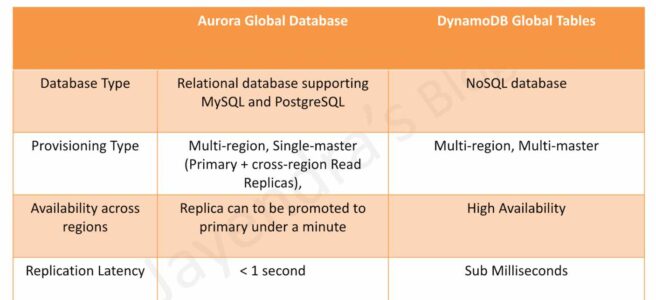AWS Aurora Global Database vs. DynamoDB Global Tables
Aurora Global Database
-
Aurora Global Database provides a relational database supporting MySQL and PostgreSQL
- Aurora Global Database consists of one primary AWS Region where the data is mastered, and up to five read-only, secondary AWS Regions.
- Aurora cluster in the primary AWS Region where the data is mastered performs both read and write operations. The clusters in the secondary Regions enable low-latency reads.
- Aurora replicates data to the secondary AWS Regions with a typical latency of under a second.
- Secondary clusters can be scaled independently by adding one or more DB instances (Aurora Replicas) to serve read-only workloads.
- Aurora Global Database uses dedicated infrastructure to replicate the data, leaving database resources available entirely to serve applications.
- Applications with a worldwide footprint can use reader instances in the secondary AWS Regions for low-latency reads.
- Typical cross-region replication takes less than 1 second.
- In case of a disaster or an outage, one of the clusters in a secondary AWS Region can be promoted to take full read/write workloads in under a minute.
- However, the process is not automatic. If the primary region becomes unavailable, you can manually remove a secondary region from an Aurora Global Database and promote it to take full reads and writes. You will also need to point the application to the newly promoted region.
DynamoDB Global Tables
- DynamoDB Global tables provide NoSQL database.
- DynamoDB Global tables provide a fully managed, multi-Region, and multi-active database that delivers fast, local, read and write performance for massively scaled, global applications.
- Global tables replicate the DynamoDB tables automatically across the choice of AWS Regions and enable reads and writes on all instances.
- DynamoDB global table consists of multiple replica tables (one per AWS Region). Every replica has the same table name and the same primary key schema. When an application writes data to a replica table in one Region, DynamoDB propagates the write to the other replica tables in the other AWS Regions automatically.
- Global tables enable the read and write of data locally providing single-digit-millisecond latency for the globally distributed application at any scale. It provides asynchronous replication with approximately 1-second replication latency for tables between two or more Regions.
- DynamoDB Global tables are designed for 99.999% availability.
- DynamoDB Global tables enable the applications to stay highly available even in the unlikely event of isolation or degradation of an entire Region, your application can redirect to a different Region and perform reads and writes against a different replica table.

AWS Certification Exam Practice Questions
- Questions are collected from Internet and the answers are marked as per my knowledge and understanding (which might differ with yours).
- AWS services are updated everyday and both the answers and questions might be outdated soon, so research accordingly.
- AWS exam questions are not updated to keep up the pace with AWS updates, so even if the underlying feature has changed the question might not be updated
- Open to further feedback, discussion and correction.
- A company needs to implement a relational database with a multi-region disaster recovery Recovery Point Objective (RPO) of 1 second and a Recovery Time Objective (RTO) of 1 minute. Which AWS solution can achieve this?
- Amazon Aurora Global Database
- Amazon DynamoDB global tables
- Amazon RDS for MySQL with Multi-AZ enabled
- Amazon RDS for MySQL with a cross-Region snapshot copy
